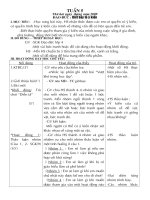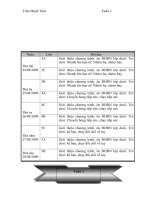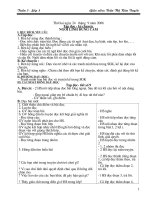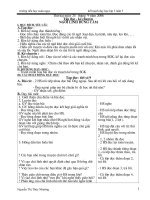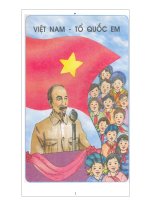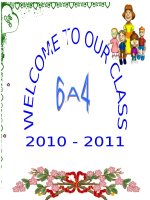5 3 1 what a great idea
Bạn đang xem bản rút gọn của tài liệu. Xem và tải ngay bản đầy đủ của tài liệu tại đây (3.34 MB, 12 trang )
Suggested levels for Guided Reading, DRA,™
Lexile,® and Reading Recovery™ are provided
in the Pearson Scott Foresman Leveling Guide.
Technology
What a
Great Idea!
by Sharon Franklin
illustrated by Victor Kennedy
Genre
Expository
nonfiction
Comprehension
Skills and Strategy
• Author’s Purpose
• Generalize
• Text Structure
Text Features
•
•
•
•
Table of Contents
Captions
Lists
Glossary
Scott Foresman Reading Street 5.3.1
ISBN 0-328-13532-1
ì<(sk$m)=bdfdcf< +^-Ä-U-Ä-U
Reader Response
What a
Great Idea!
1. Why do you think the author wrote about Hsi Ling
Shi, when instead she could have written more about
young inventors from modern times?
2. For each invention the author describes, she explains
why it was invented. Use a chart like the one below to
each inventor’s
by list
Sharon
Franklininvention and why it was invented.
Invention
illustrated
by Victor KennedyWhy it was invented
3. Think of some scoundrels you’ve read about in history
or fiction. Name one. Tell what made that person a
scoundrel.
4. Go back to the image of Chester Greenwood’s
earmuff patent on page 6. How did it help you to
better understand patents?
Editorial Offices: Glenview, Illinois • Parsippany, New Jersey • New York, New York
Sales Offices: Needham, Massachusetts • Duluth, Georgia • Glenview, Illinois
Coppell, Texas • Ontario, California • Mesa, Arizona
TABLE OF CONTENTS
CHAPTER 1
4
Three Young Inventors
CHAPTER 2
10
The Patent Process
CHAPTER 3
12
More Young Inventors
CHAPTER 4
16
You Too Can Be an Inventor!
Glossary
20
Every effort has been made to secure permission and provide appropriate credit for
photographic material. The publisher deeply regrets any omission and pledges to
correct errors called to its attention in subsequent editions.
Unless otherwise acknowledged, all photographs are the property of Scott Foresman,
a division of Pearson Education.
Photo locators denoted as follows: Top (T), Center (C), Bottom (B), Left (L), Right (R),
Background (Bkgd)
Illustrations by Victor Kennedy
Photographs: 4 Corbis; 5 Corbis; 7 Library of Congress; 12 Getty Images; 13 AP/Wide
World Photos
ISBN: 0-328-13532-1
Copyright © Pearson Education, Inc.
All Rights Reserved. Printed in the United States of America. This publication is
protected by Copyright, and permission should be obtained from the publisher
prior to any prohibited reproduction, storage in a retrieval system, or transmission
in any form by any means, electronic, mechanical, photocopying, recording, or
likewise. For information regarding permission(s), write to: Permissions Department,
Scott Foresman, 1900 East Lake Avenue, Glenview, Illinois 60025.
2 3 4 5 6 7 8 9 10 V0G1 14 13 12 11 10 09 08 07 06 05
3
4
Chapter One Three Young Inventors
Hsi Ling Shi Invents Silk
What do you think of when you hear the word
inventor? Maybe you think of someone working
hard in a laboratory. Perhaps you see a person bent
over a computer, with tools lying all around. Or
possibly, you see an image of Ben Franklin, Thomas
Edison, or George Washington Carver.
Would it surprise you to learn that kids are
inventors too? Young people have been inventing
for a very long time. Keep reading to find out about
the great ideas that kids have come up with.
Five thousand years ago, a fourteen-year-old
Chinese empress named Hsi Ling Shi invented
the process of weaving silk. It all started when a
silkworm cocoon fell from a tree into a cup of tea
that Hsi Ling Shi was drinking.
Hsi Ling Shi saw that threads appeared when the
cocoon came apart in the tea. She pulled on the
threads. They were very strong! Hsi Ling Shi used the
threads to weave fabric. The fabric was strong, soft,
and beautiful.
Soon, her Chinese subjects began weaving silk.
Merchants from faraway countries came to China to
buy silk, since only the Chinese knew how to make it.
All of this was started by a fourteen-year-old girl!
This painting shows Japanese women making silk.
Silkworms spin cocoons made out of silk.
5
Chester’s Earmuffs
Thousands of years after Hsi Ling Shi invented
silk, fifteen-year-old Chester Greenwood invented
earmuffs. Chester lived in Maine, a state that has
cold winters. Chester’s ears got so cold that he could
only play outside for brief periods of time.
Chester wanted to keep playing outside without
his ears getting cold. Then he got an idea! He bent a
piece of wire to the shape of his head. He asked his
grandmother to sew two circles padded with fabric.
Chester attached the circles to the ends of the wires.
Then he put his creation onto his head!
At first, people thought Chester looked funny with
his earmuffs. But when they saw how long he could
stay out in the cold, they looked at him admiringly.
Soon, people were buying earmuffs from Chester!
Chester Greenwood didn’t stop at earmuffs. He
was eventually awarded more than one hundred
patents for his inventions.
6
Chester Greenwood is wearing
his invention.
7
Jeanie Low Reaches High
Most people would find it frustrating having to
struggle to reach up to a sink. Jeanie Low isn’t most
people. She invented the Kiddie Stool!
When Jeanie was little, she had to stand on a
stool to reach the sink in her house. But Jeanie’s
parents bumped into the stool when they used the
sink, which created a problem.
Jeanie wanted a stool that wouldn’t be in the
way. She realized that a step that folded up against
the sink cabinet might work. She could fold the step
down when she needed it. When she didn’t need it,
she could fold it up flat against the cabinet. Then
her parents could use the sink without bumping into
anything!
At first, Jeanie thought she could use wire to
attach the step. But she realized that wire could be
dangerous. Then Jeanie figured out that magnets
would permit her to keep the step in place.
Jeanie and her dad gathered some supplies.
Together, they built and tested a Kiddie Stool. It worked!
Around the same time, Jeanie’s school had a fair
where students could display their inventions. Jeanie
entered her Kiddie Stool and won first prize!
Soon, Jeanie was appearing on TV to talk about
her invention. People wrote articles about her. Jeanie
became interested in inventing other things. She
joined an inventors’ club where she could talk with
other people about her ideas.
Jeanie Low became
famous for her invention.
The Kiddie Stool
8
9
Chapter Two The Patent Process
Do you remember that Chester Greenwood got
a patent for his earmuffs? That was so no one else
could make and sell earmuffs. Chester didn’t want
any scoundrels to copy or make money from his
invention. Jeanie also got a patent for her Kiddie
Stool.
There are several steps required to get a patent.
You have to show that no one else has come up with
your invention before you.
Getting a patent takes time and money. Serious
inventors usually hire lawyers. These lawyers make
sure that no one else has had the same idea and
applied for a patent. They also help fill out the
patent application correctly.
Jeanie and her parents had to go through all
the steps in the chart below before Jeannie got her
patent. When she was ten years old, Jeanie became
one of the youngest patent holders ever!
HOW TO GET A PATENT
1
Draw up a sketch and write an explanation of
the invention you want patented.
2
Hire a patent lawyer.
3
Have the patent lawyer do a search to make
sure no one already has a similar patent.
4
Mail a patent application (with the sketch and
explanation) to the U.S. Patent Office.
5
The patent office decides whether or not to
give you a patent. This may take years.
A Copy of an Actual Patent
This patent is for a lock and key.
Patents can protect your ideas.
10
11
Chapter Three More Young Inventors
Inventing to Help a Friend
Josh Parsons was a ten-year-old baseball player
when he became an inventor. He wanted to help
someone who was having difficulty in sports.
Josh’s dad was a baseball coach. He told Josh
about a young boy named David who wanted to be
on the team. David’s arms had been amputated, or
removed by surgery, around the elbows. Despite this
handicap, David had learned to catch and bat a ball.
But he could not throw.
Jim Abbott
Josh thought he could make something that
would help David throw. David had found a way
to attach a baseball mitt to the end of one of his
elbows. He could catch with it. Josh thought that a
scoop on the other arm might allow David to throw
the ball. He did some experiments with paper to test
his idea. Then he sewed a scoop out of leather.
David tried on Josh’s invention. First, he caught
the ball. Then he put the ball into the scoop on his
other arm. Finally, he swung his arm so that the ball
went flying out of the scoop. It worked! Thanks to
Josh’s invention, David made the team.
Pete Gray
Like David, Jim Abbott
and Pete Gray were
disabled baseball
players. Both played in
the major leagues.
12
13
Inventing for the Fun of It
Jeanie Low’s younger sister, Elizabeth, is also an
inventor. One day, Elizabeth was visiting her father
at his medical office. Elizabeth was only four years
old, but she wanted to enter an invention in that
year’s invention fair. Then she spotted the rubber
gloves her father wore to examine patients. They
gave her an idea!
Elizabeth took some gloves home and filled them
with sand. She bent the fingers. Then she decorated
the outsides so they looked fun and cheery.
Elizabeth named her invention Happy Hands and
took it to the invention fair. She told people her
Happy Hands could be used as paperweights or to
hold toys, jewelry, or other supplies. The judges liked
Elizabeth’s invention, and they gave her first prize!
So many people were interested in Elizabeth’s
Happy Hands that she decided to patent her idea.
When Elizabeth was nine, she received a patent
for Happy Hands. That made her an even younger
patent holder than her sister Jeanie!
Elizabeth Low invented
Happy Hands.
14
15
Chapter Four You Too Can Be an Inventor!
Josh Parsons and the Low sisters are just a few
of our country’s young inventors. Every year,
students just like you enter invention fairs.
Many of these students go on to other
fairs and contests. And a few are awarded
patents for their inventions!
Would you like to be an inventor?
Inventing can be enjoyable and rewarding.
Think of the fun and pleasure you could
give people by inventing something that no
one has ever thought of!
Would you like to give it a try? The list
on page 17 describes the steps you need to
take. Read the list carefully. Then read the
helpful hints on pages 18 and 19. Can you
imagine going through this process?
16
HOW TO BE AN INVENTOR
1
Come up with an idea for your invention.
2
Research and develop a design for your invention.
3
Create a working model of your invention.
4
Name your invention.
5
Enter your invention in a fair.
17
Putting It All Together
To start the flow of good ideas, you have to be
on the lookout for things that could be turned into
inventions. Carry a pencil and a notebook with you.
When an idea strikes, jot it down right away! A quick
sketch will help you remember your thoughts.
Browse through library books to read about
inventors and their inventions. Use an Internet search
engine to find information on the Web.
Jot down your ideas in a
notebook.
Do research to find out if your idea has already
been patented. It would be worthless for you to
do a lot of work, only to find out that someone has
already invented and patented your idea! If your
idea hasn’t been patented, make a detailed sketch.
Also, explain how it works. Then you can have your
parents or your teacher help you fill out a patent
application.
The most important thing is to have confidence
in your ideas. Why not give inventing a try? Who
knows, you just might become the next Elizabeth
Low or Chester Greenwood!
Jeanie Low’s
Kiddie Stool
Elizabeth Low’s
Happy Hands
18
19
Glossary
admiringly adv. with
wonder, pleasure, and
approval.
permit v. to let; allow.
scoundrels n. evil,
dishonorable people;
villains; rascals.
Reader Response
subjects n. people who
are under the power,
control, or influence of
others, as subjects of a
king or queen.
worthless adj. without
value; good-for-nothing;
useless.
1. Why do you think the author wrote about Hsi Ling
Shi, when instead she could have written more about
young inventors from modern times?
2. For each invention the author describes, she explains
why it was invented. Use a chart like the one below to
list each inventor’s invention and why it was invented.
Invention
Why it was invented
3. Think of some scoundrels you’ve read about in history
or fiction. Name one. Tell what made that person a
scoundrel.
4. Go back to the image of Chester Greenwood’s
earmuff patent on page 6. How did it help you to
better understand patents?
20

